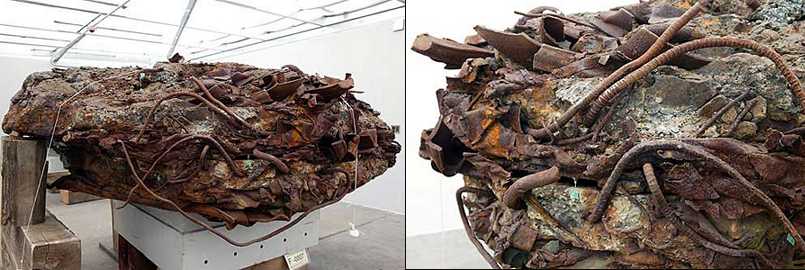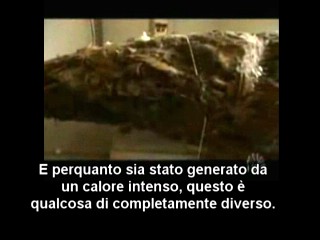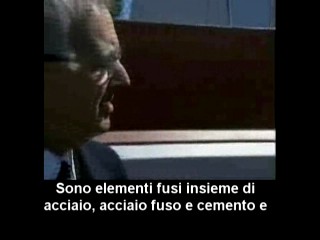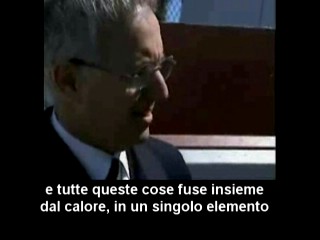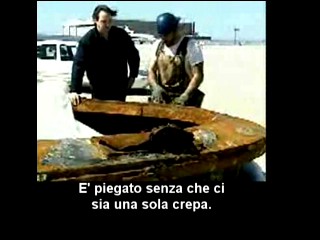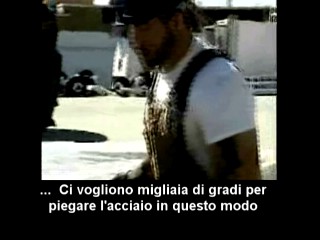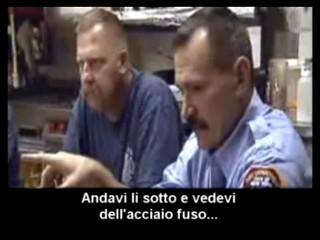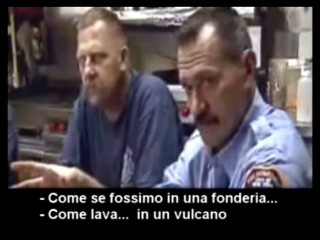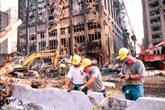|
ATTIVISSIMO: Eccomi qua. ho
dovuto fare questo lavoraccio supplementare, perchè mi sembravi
molto poco informato sull’argomento, e hai addirittura negato la
presenza di acciaio fuso al WTC.
Invece l’acciaio fuso c’era, e le testimonianze, come vedi sono molteplici. Ce ne sono almeno il triplo, volendo, ma a meno che tu mi dica che tutti costoro “si sono sbagliati”, direi che per sostenere la versione ufficiale sia necessario spiegare chiaramente come tutto ciò sia potuto accadere. Chiedo scusa a chi non conosce bene l'inglese, ma non ho avuto assolutamente il tempo di tradurre il testo (mi sono limitato a qualche passagiop fondamentale). TESTIMONIANZE SULL'ACCIAIO FUSO Dead On Arrival The NIST 9/11 Report on the WTC Collapse By Mark H. Gaffney Note to the reader: The
following is a critique of the National Institute for Standards and
Technology (NIST) report on the World Trade Center (WTC) collapse. The
43 volume NIST report was the result of a 3 year investigation, and was
released in September 2005. It remains the official US government
explanation for why the WTC collapsed on 9/11. As you are about to
discover, the report itself collapses under scrutiny. There is no doubt
that the NIST investigation was politically controlled by limiting its
scope, thereby making the truth unobtainable. This is one way to neuter
an investigation.
12/21/06 -- -- Fires raged at ground zero for many weeks after 9/11. In fact, it was not until December 19, 2001 that the NYC fire marshall declared the fires extinguished. The fires burned long into the cleanup. The removal of steel beams and debris from the top of the pile allowed oxygen to reach the fires smoldering below. As a result, the flames often flared up, hampering workers on site. Joel Meyerowitz, a photographer, made note of this in his 2006 retrospective book, Aftermath. Armed with his trusty camera Meyerowitz roamed ground zero for months following the attack. Police repeatedly ejected him, but he kept returning in order to document what had happened. Eventually Meyerowitz amassed an impressive photographic record. In his fine book he remarks that the ground in places was so hot it melted the workmen’s rubber boots. But Meyerowitz was hardly the first to comment on the pile’s incredible residual heat. The first accounts of molten steel came just hours after the attack: from the search and rescue teams who were among the first on the scene. Sarah Atlas, a member of New Jersey Task Force One Search and Rescue, was one of these emergency responders. Sarah reported seeing molten steel in the pile even as she searched in vain for survivors.[1]
Many have denied the existence of molten steel at ground zero. But there are too many eyewitness accounts to dismiss, including the testimony of engineers, city officials and other competent professionals who toured the ruin. One of these, Dr Keith Eaton, Chief Executive of the London-based Institution of Structural Engineers, later wrote in The Structural Engineer about what he had seen, namely: “molten metal which was still red-hot weeks after the event,” as well as “four-inch thick steel plates sheered and bent in the disaster.”[2] A similar account came from Leslie E. Robertson, an engineer who helped design the WTC. He is currently a partner at Leslie E. Robertson Associates, a structural consulting firm that was under contract to the WTC at the time of the tragedy. In a keynote address Robertson reportedly told the Structural Engineers Association of Utah that: “...as of 21 days after the attack the fires were still burning and molten steel still running.”[3] Public health officials/experts also toured the scene of destruction. Alison Geyh Ph.D., an Assistant Professor of Environmental Health at Johns Hopkins, was with one of these teams. She wrote that “In some pockets now being uncovered they are finding molten steel.”[4] The fact was even reported to the 9/11 Commission by Kenneth Holden, Commissioner of the city of New York. He told the panel about seeing “molten metal” during a walkthrough.[5] The evidence accumulated even as the cleanup progressed. Work crews removing the mountain of debris, piece by piece, discovered pools of molten steel beneath the pile, where the towers had stood. One pool was found at the bottom of the elevator shafts. Some of the pools were not found until 3, 4, even 5 weeks after 9/11. Contractors working on site confirmed these discoveries. Such as Peter Tully, president of Tully Construction of Flushing New York, who was one of four contractors engaged by New York City to handle the cleanup. During an August 2002 interview Tully told the American Free Press that indeed workmen had seen the molten pools.[6] The same interview included a statement by Mark Loizeaux, president of Controlled Demolition, Inc., who, years before, ramrodded the cleanup of the bombed Federal Building in Oklahoma City. Loizeaux was called in by Tully to draft the cleanup plan for the WTC site. Loizeaux said, “Yes, hot spots of molten steel were seen in the basements.” Molten steel was also found under WTC 7. These pools of molten metal have never been explained. Loizeaux told the American Free Press that the continuing fires were fueled by “paper, carpet and other combustibles packed down the elevator shafts by the tower floors as they ‘pancaked’ into the basement.” Manuel Garcia, a physicist, has suggested that cars left in parking garages under the WTC contained gasoline that may have fueled the fires.[7] Both are probably correct. But none of these fires were hot enough to melt steel. Indeed, none of the combustibles in the wreckage burned anywhere near the melting point of construction grade steel beams (2800 °F). As noted, the smoldering fires for the most part were oxygen-starved. The persistence of molten steel under the WTC for many weeks is extraordinary–––and anomalous. Evidently, the hot spots under the wreckage were not in the least fazed by heavy rain on September 14-15, nor by the millions of gallons of water that firemen and cleanup crews sprayed on the smoking ruins. Five days after the attack the US Geological Survey (USGS) found dozens of “hot spots” in the wreckage via remote sensing, i.e., an infrared spectrometer (AVIRIS). The two hottest spots were under WTC 2 and WTC 7. The USGS recorded surface temperatures as high as 747°C (1376°F)).[8] The molten pools below the pile must have been at least twice as hot––––hot enough to evaporate rain and the water sprayed on the pile, long before it reached the bottom. 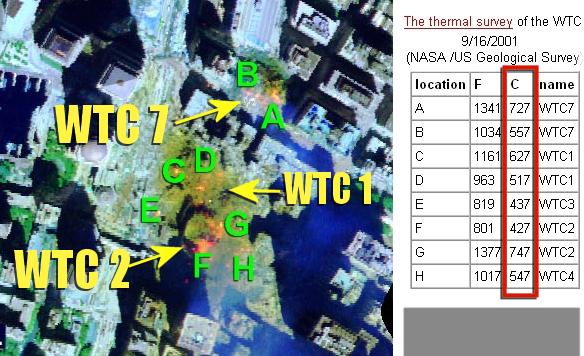
Notes 1. Penn Arts and Sciences, Summer 2002. <www.sas.upenn.edu/sasalum/newsltr/summer2002/k911.html> 2. Dr Keith Eaton, The Structural Engineer 3, September 2002, #6. 3. James Williams, “WTC a Structural Success,” SEAU NEWS, The Newsletter of the Structural Engineers Association of Utah, October 2001, #3. 4. Magazine of Johns Hopkins Public Health, late fall, 2001. When I contacted Dr Geyh she confirmed the report. She stated that people involved in the clean up effort told her they had seen molten steel in the debris. 5. Commissioner Holden’s testimony before the 911 Commission is posted at http://www.globalsecurity.org/security/library/congress/9-11_commission/030401-holden.htm 6. Christopher Bollyn, “Seismic Evidence Points to Underground Explosions Causing WTC Collapse” American Free Press, August 28, 2002. http://www.serendipity.li/wot/bollyn2.htm 7. Manuel Garcia, “The Thermodynamics of 9/11,” November 28, 2006. posted at http://www.counterpunch.org/thermo11282006.html 8. The results are posted at http://pubs.usgs.gov/of/2001/ofr-01-0429/thermal.r09.html
|
||||||||||||||||||||
 Danger in the Dust  It is 4 a.m. in New
York City as four researchers from the School enter the site of the
World Trade Center disaster on foot. Each is lugging from 50 to 90
pounds of air-monitoring equipment onto Ground Zero. In the dark, the
tangled pile of wreckage takes on a distinctly hellish cast. It is 4 a.m. in New
York City as four researchers from the School enter the site of the
World Trade Center disaster on foot. Each is lugging from 50 to 90
pounds of air-monitoring equipment onto Ground Zero. In the dark, the
tangled pile of wreckage takes on a distinctly hellish cast."Fires are still actively burning and the smoke is very intense," reports Alison Geyh, PhD. "In some pockets now being uncovered, they are finding molten steel." |
||||||||||||||||||||
NEW YORK DEPARTMENT OF SANITATION “Once the area was cleaned, normal commercial trash collections resumed by the haulers that are licensed and regulated by the Trade Waste Commissioner,” Dawkins says. But for about two and a half months after the attacks, in addition to its regular duties, NYDS played a major role in debris removal — everything from molten steel beams to human remains — running trucks back and forth between Ground Zero and Fresh Kills landfill, which was reopened to accommodate the debris. Kathy Dawkins, NYDS spokeswoman. LINK |
||||||||||||||||||||
Ron Burger - Public Health Advisor at the National Center for Environmental Health, Centers for Disease Control and Prevention: The National Environmental Health Association’s paper “Messages in the Dust” quotes Burger: “Feeling the heat, seeing the molten steel, the layers upon layers of ash, like lava, it reminded me of Mt. St. Helens and the thousands who fled that disaster.” |
||||||||||||||||||||
Guy Lounsbury - Member of New York Air National Guard’s 109th Air Wing: National Guard Magazine article written by Lounsbury (excerpt): “One fireman told us that there was still molten steel at the heart of the towers' remains. Firemen sprayed water to cool the debris down but the heat remained intense enough at the surface to melt their boots.” LINK |
||||||||||||||||||||
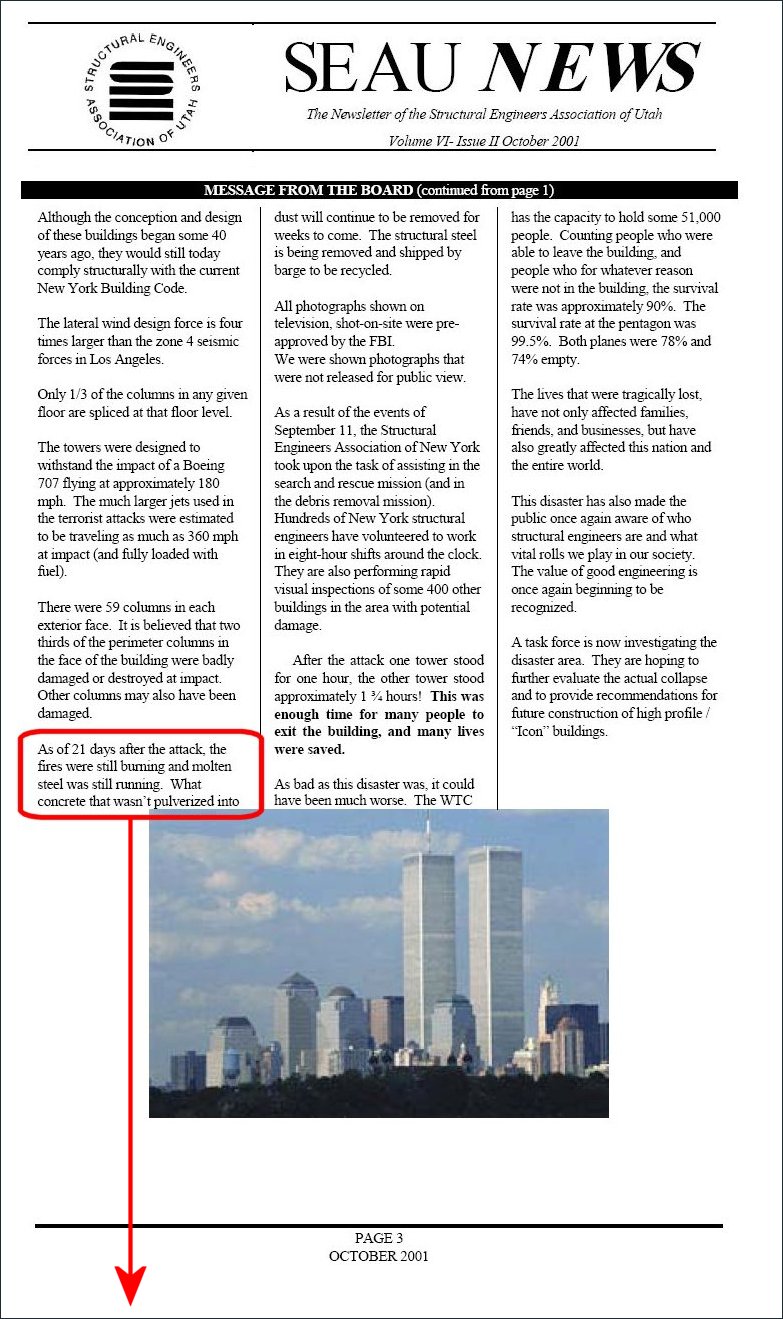 As of 21 days after the attacks, the fires were still burning and molten steel was still running. LINK |
||||||||||||||||||||
 Handheld app eased recovery tasks
Anyone at the site—a policeman, a crane operator or a Federal Emergency Management Agency official—who discovered a body part had to notify the fire department. A firefighter would then collect the remains and write down a tracking number, date, time, description and location. The Fire Department mapped Ground Zero into grids and cells. A fireman might locate the remains as “in grid B, cell 7,” write it on a slip of paper and take it to the quadrant command center. A FEMA agent would then transcribe the note and enter it into a database. Not only was this laborious for the firefighters, but the working conditions were hellish, said Greg Fuchek, vice president of sales for LinksPoint Inc. of Norwalk, Conn. For six months after Sept. 11, the ground temperature varied between 600 degrees Fahrenheit and 1,500 degrees, sometimes higher. “In the first few weeks, sometimes when a worker would pull a steel beam from the wreckage, the end of the beam would be dripping molten steel,” Fuchek said. LINK |
||||||||||||||||||||
Zolfo,
ossigeno e ferro.
|
|
Una colonna di due
centimetri e mezzi di spessore è stata ridotta alla
metà. I suoi bordi, arrotolati come carta da papiro, sono
diventati
taglienti quasi quanto un rasoio. Larghi fori - alcuni più
larghi di un
dollaro d'argento, fanno entrare luce in quello che prima era una
compatta giuntura/lamina d'acciaio.
|
Jonathan Barnett
Ronald R. Biederman
R. D. Sisson, Jr.
CLimited Metallurgical Examination
C.1 Introduction
Two structural steel members with unusual erosion patterns were observed in the WTC debris field. The first appeared to be from WTC 7 and the second from either WTC 1 or WTC 2. Samples were taken from these beams and labeled Sample 1 and Sample 2, respectively. A metallurgic examination was conducted.
C.2 Sample 1 (From WTC 7)
Several
regions in the section of the beam shown in Figures C-1 and C-2 were
examined to determine microstructural changes that occurred in the A36
structural steel as a result of the events of September 11, 2001, and
the subsequent fires. Although the exact location of this beam in the
building was not known, the severe erosion found in several beams
warranted further consideration. In this preliminary study, optical and
scanning electron metallography techniques were used to examine the
most severely eroded regions as exemplified in the metallurgical mount
shown in Figure C-3. Evidence of a severe high temperature
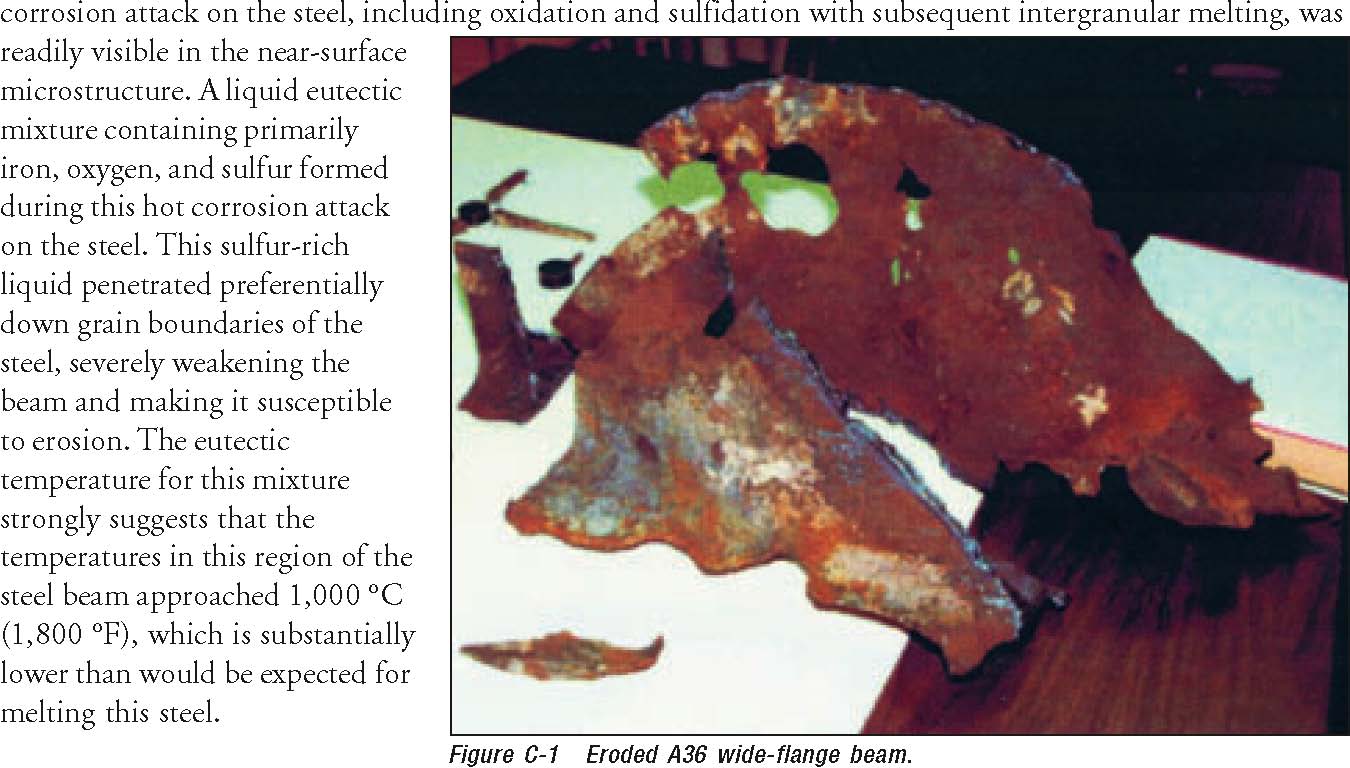
readily
visible in the near-surface microstructure. A liquid eutectic mixture
containing primarily iron, oxygen, and sulfur formed during this hot
corrosion attack on the steel. This sulfur-rich liquid penetrated
preferentially down grain boundaries of the steel, severely weakening
the beam and making it susceptible to erosion. The eutectic temperature
for this mixture strongly suggests that the temperatures in this region
of the steel beam approached 1,000 °C (1,800 °F), which is
substantially lower than would be expected for melting this steel.
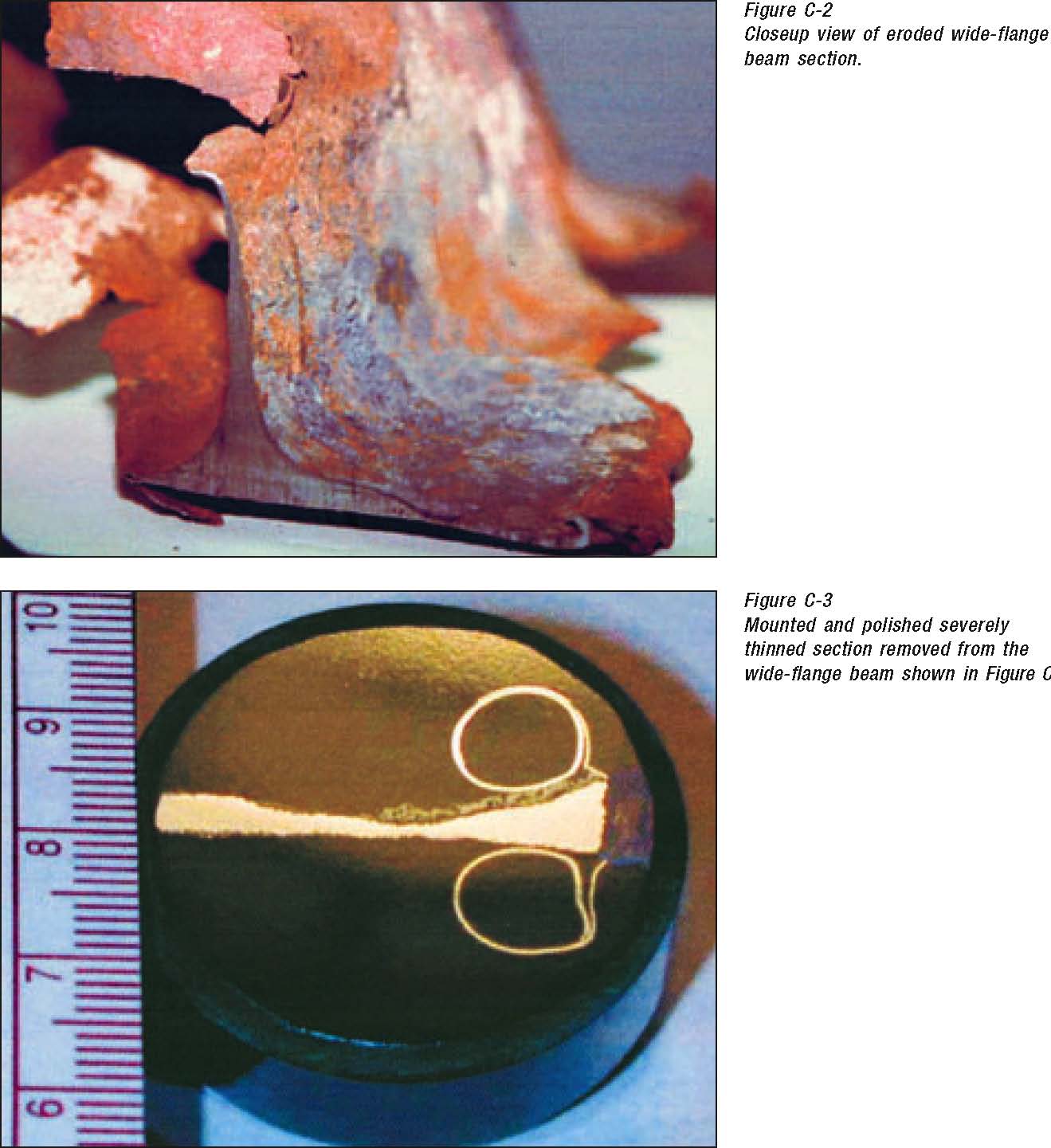
Figure C-3 Mounted and polished severely thinned section removed from the wide-flange beam shown in Figure C-1.
When steel cools below the eutectic temperature, the liquid of eutectic composition transforms to two phases, iron oxide, FeO, and iron sulfide, FeS. The product of this eutectic reaction is a characteristic geometrical arrangement that is unique and is readily visible even in the unetched microstructure of the steel. Figures C-4 and C-5 present typical near-surface regions showing the microstructural changes that occur due to this corrosion attack. Figure C-6 presents the microstructure from the center of a much thicker section of the steel that is unaffected by the hot corrosion. Figure C-7 illustrates the deep penetration of the liquid into the steel’s structure. In order to identify the chemical composition of the eutectic, a qualitative chemical evaluation was done using energy dispersive X-ray analysis (EDX) of the eutectic reaction products. Figure C-8 illustrates the results of this analysis.
APPENDIX C : Limited Metallurgical Examination
Figure C-8 Qualitative chemical analysis.
|
Riassunto del reperto 1:
L'assottigliamento dell'acciaio è avvenuto tramite una corrosione ad alta temperatura, a causa di una combinazine di ossidazione e solfurazione. Il riscaldamento dell'acciaio in un ambiento corrosivo caldo che si avvicina ai 1000° C. produce una mistura eutettica di ferro, ossigeno e zolfo che ha liquefatto l'acciaio. L'azione della solfurazione sui grani esterni dell'acciaio ha accelerato la corrosione e l'erosione dell'acciaio, Quindi Barnett parla di ACCIAIO LIQUEFATTO |
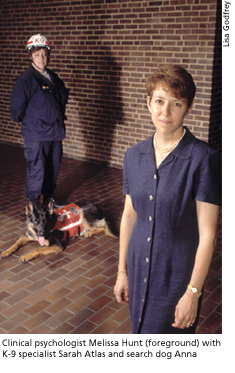 K-9/11
K-9/11 “The [NYFD] people who called us had been
killed,” Atlas considered as she surveyed the tons and acres of
wreckage. “Nobody’s going to be alive.” Fires burned and
“The [NYFD] people who called us had been
killed,” Atlas considered as she surveyed the tons and acres of
wreckage. “Nobody’s going to be alive.” Fires burned and 



